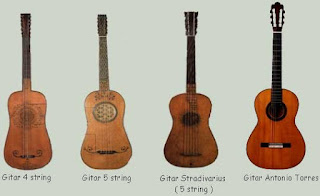
On the guitar, tablature, or often called tab is a graphical notation system that represent strings and guitar fret of stem / neck of a guitar.
There are several symbols contained in tablature / guitar tab.
The following symbols on the guitar tablature and its understanding:
1. Hammer On
In tablature / guitar tab, hammer on is denoted by the letter 'h', in tablature between fret learned and that in the hammer (eg 5H6).
2. Pull Off
In tablature / guitar tabs, pull off is denoted by the letter 'p', (eg 7p5)
However, often symbolized by a '^', can be used to pull off (example 7 ^ 5) and hammer on (example 5 ^ 6).
3. Bend
In tablature / guitar tab, bend denoted by the letter 'b' (ie 7B9).
Bend can also be written [7b (9)], or b omitted [7 (9)]
4. Release
In tablature / guitar tab, release denoted by the letter 'r', (example 9r7).
Release the reverse / pair of bend, (example 7b9r7).
5. Slide
Slide has two kinds:
#Slide Up (Ascending Slide) In tablature / guitar tab, slide up denoted by '/', (example 5/7).
#Slide Down (Descending Slide) In tablature / guitar tab, slide down denoted by '\', (eg 7 \ 5).
Can also be incorporated between slides up and down (eg 5/7 \ 5)
Sometimes slide symbolized by the letter 's'.
6. Harmonic
In tablature / guitar tab, harmonic denoted by '<>'.
7. Tapping
In tablature / guitar tab, tapping denoted by the letter 't',
tapping often paired with pull off and hammer on
(Example 2h5t12p5p2).
8. Vibrato
In tablature use of vibrato can be denoted in several ways, the symbol '~', symbol '~ ~ ~ ~', can also use the letter 'v'.
9. Mute
In tablature / guitar tabs, mute denoted by the letter 'x'.
Thank you for reading Understanding Symbols On Guitar tablature.















